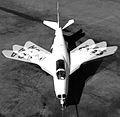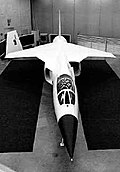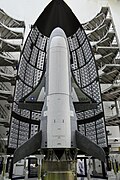List of X-planes

The X-planes are a series of experimental United States aircraft and rockets, used to test and evaluate new technologies and aerodynamic concepts. They have an X designator within the US system of aircraft designations, which denotes the experimental research mission.
Not all US experimental aircraft have been designated as X-planes; some received US Navy designations before 1962,[1] while others have been known only by manufacturers' designations,[N 1] non-'X'-series designations,[N 2] or classified codenames.[N 3] This list only includes the designated X-planes.
History
The X-planes concept officially came into being in 1944, as a joint programme between the
The first experimental aircraft specification, for a
X-planes have since accomplished many aviation "firsts" including breaking speed and altitude barriers, varying wing sweep in flight, implementing exotic alloys and propulsion innovations, and many more.[2]
New X-planes appeared fairly regularly for many years until the flow temporarily stopped in the early 1970s. A series of experimental hypersonic projects, including an advanced version of the Martin Marietta X-24 lifting body, were turned down. Eventually issues with the Rockwell HiMAT advanced UAV led to a crewed X-plane with forward sweep, the Grumman X-29, which flew in 1984.[5]
Some of the X-planes have been well publicized, while others, such as the X-16, have been developed in secrecy.
Most X-planes are not expected to go into full-scale production; one exception was the
List
In the list, the date is that of the first flight, or of cancellation if it never flew.
| Image | Type | Manufacturer | Agency | Date | Role | Notes |
|---|---|---|---|---|---|---|

|
X-1 | Bell | NACA
|
1946 | High-speed and high-altitude flight | First aircraft to break the sound barrier in level flight. Proved aerodynamic viability of thin wing sections.[10] |

|
X-1A X-1B X-1C X-1D | Bell | USAF, NACA | 1951 | High-speed and high-altitude flight | |

|
X-1E | Bell | USAF, NACA | 1955 | High-speed and high-altitude flight | |

|
X-2 | Bell | USAF | 1952 | High-speed and high-altitude flight | First aircraft to exceed Mach 3.[11] |

|
X-3 Stiletto
|
Douglas
|
USAF, NACA | 1952 | Highly loaded trapezoidal wing | Titanium alloy construction; Underpowered, but provided insights into inertia coupling.[12] |

|
X-4 Bantam
|
Northrop | USAF, NACA | 1948 | Transonic tailless aircraft[13] | |

|
X-5 | Bell | USAF, NACA | 1951 | variable geometry | First aircraft to fly with variable wing sweep.[14] |

|
X-6 | Convair | USAF, AEC | 1957 | Nuclear Propulsion | Not built. The |

|
X-7 | Lockheed | USAF, USA, USN | 1951 | Ramjet engines.[17]
|
|
| X-8 Aerobee | Aerojet | NACA, USAF, USN | 1949 | Upper air research[18] | Later models used as sounding rockets. | |
X-9 Shrike
|
Bell | USAF | 1949 | Guidance and propulsion technology | Assisted development of GAM-63 Rascal missile.[19]
| |

|
X-10 | North American | USAF | 1953 | SM-64 Navajo missile testbed.[20]
|
|
X-11
|
Convair | USAF | 1953 | Proposed SM-65 Atlas missile testbed.[21] | ||
X-12
|
Convair | USAF | 1953 | Proposed SM-65 Atlas missile testbed.[22] | ||

|
X-13 Vertijet
|
Ryan
|
USAF, USN | 1955 | Vertical takeoff and landing (VTOL)
|
tailsitting VTOL flight.[23]
|

|
X-14 | Bell | USAF, NASA | 1957 | VTOL | Vectored thrust configuration for VTOL flight.[24]
|

|
X-15 | North American | USAF, NASA | 1959 | Hypersonic , high-altitude flight
|
First crewed hypersonic aircraft; capable of suborbital spaceflight.[25] |

|
X-15A-2 | North American | USAF, NASA | 1964 | Hypersonic , high-altitude flight
|
Major Pete Knight flew the X-15A-2 to a Mach 6.70, making it the fastest piloted flight of the X-plane program. |

|
X-16 | Bell | USAF | 1954 | High-altitude reconnaissance[26] | "X-16" designation used to hide true purpose.[27] Canceled and never flew. |
| X-17 | Lockheed | USAF, USN | 1956 | High Mach number reentry.[28]
|
||

|
X-18 | Hiller | USAF, USN | 1959 | Vertical and/or short take-off and landing (V/STOL) | Evaluated the tiltwing concept for VTOL flight.[29] |

|
X-19 | Curtiss-Wright | Tri-service | 1963 | Tandem tiltrotor VTOL[30] | XC-143 designation requested but turned down.[31] |

|
X-20 Dyna-Soar
|
Boeing | USAF | 1963 | Reusable spaceplane | Intended for military missions.[32] Canceled and never built. |

|
X-21A | Northrop | USAF | 1963 | Boundary layer control[33] | |

|
X-22 | Bell | Tri-service | 1966 | Quad ducted fan tiltrotor STOVL[34] | |

|
X-23 PRIME
|
Martin Marietta | USAF | 1966 | Maneuvering atmospheric reentry[35]
|
Designation never officially assigned.[31] |

|
X-24A
|
Martin Marietta | USAF, NASA | 1969 | Low-speed lifting body[36] | |

|
X-24B
|
Martin Marietta | USAF, NASA | 1973 | Low-speed lifting body[37] | |

|
X-25 | Bensen | USAF | 1955 | Commercial light autogyro for downed pilots.[38] | |
 
|
X-26 Frigate
|
Schweizer
|
US Army , USN
|
1967 | Training observation aircraft[39]
|
|

|
X-27
|
Lockheed | None | 1971 | high-performance research aircraft. High-performance fighter[40] | Proposed development of Lockheed CL-1200 Lancer. Canceled and never flew. |

|
X-28 Sea Skimmer | Osprey | USN | 1970 | Low-cost aerial policing seaplane[41] | |

|
X-29 | Grumman | DARPA, USAF, NASA | 1984 | Forward-swept wing[42] | |

|
X-30 NASP | Rockwell | NASA, DARPA, USAF | 1993 | Single-stage-to-orbit spaceplane[43] | Canceled and never built. |

|
X-31 | Rockwell-MBB | DARPA, USAF, BdV
|
1990 | Thrust vectoring supermaneuverability[44] | |
| X-32A | Boeing | USAF, USN, USMC, RAF | 2000 | Joint Strike Fighter[45]
|
||

|
X-32B | 2001 | ||||

|
X-33 | Lockheed Martin | NASA | 2001 | Half-scale reusable launch vehicle prototype.[46] | Prototype never completed. |

|
X-34 | Orbital Sciences
|
NASA | 2001 | Reusable pilotless spaceplane.[47] | Never flew. |

|
X-35A | Lockheed Martin | USAF, USN, USMC, RAF | 2000 | Joint Strike Fighter[48]
|
|

|
X-35B | 2001 | First in family to use VTOL. Also used unconventional mode of lift engine (lift fan). | |||

|
X-35C | 2000 | ||||

|
X-36 | McDonnell Douglas | NASA | 1997 | 28% scale tailless fighter[49] | |

|
X-37 | Boeing | USAF, USSF, NASA | 2010 | Reusable orbital spaceplane[50] | Drop test performed in 2006. Seven flights to space since 22 April 2010 |

|
X-38 | Scaled Composites | NASA | 1998 | Lifting body Crew Return Vehicle[51] | |
X-39
|
Unknown | USAF | Future Aircraft Technology Enhancements (FATE) program.[52] | Designation never officially assigned.[31] | ||

|
X-40A | Boeing | USAF, NASA | 1998 | 80% scale Space Maneuver Vehicle X-37 prototype.[53] | |

|
X-41 | Unknown | USAF | Maneuvering re-entry vehicle.[54] | ||
| X-42 | Unknown | USAF | Expendable liquid propellant upper-stage rocket.[55] | |||

|
X-43 Hyper-X | Micro-Craft | NASA | 2001 | Hypersonic Scramjet[56] | |

|
X-44 MANTA
|
Lockheed Martin | USAF, NASA | 2000 | F-22-based Multi-Axis No-Tail Aircraft thrust vectoring[57]
|
Canceled, never flew. |

|
X-45 | Boeing | DARPA, USAF | 2002 | Unmanned combat air vehicle (UCAV)[58]
|
|

|
X-46 | Boeing | DARPA, USN | 2003 | Unmanned combat air vehicle (UCAV).[59]
|
Naval use. Canceled, never flew. |

|
X-47A Pegasus
|
Northrop Grumman | DARPA, USN | 2003 | Unmanned combat air vehicle (UCAV)[60]
|
Naval use. |

|
X-47B | Northrop Grumman | DARPA, USN | 2011 | UCAV | Naval use. |
| X-47C | Northrop Grumman | USAF | Manned bomber | Proposal for a new-generation strategic bomber. Design only. | ||

|
X-48 | Boeing | NASA | 2007 | Blended Wing Body (BWB)[61]
|
|

|
X-49 SpeedHawk | Piasecki | US Army | 2007 | Compound helicopter Vectored Thrust Ducted Propeller (VTDP) testbed.[62]
|
|
| X-50 Dragonfly | Boeing | DARPA | 2003 | Canard Rotor/Wing[63]
|
||

|
X-51 Waverider
|
Boeing | USAF | 2010[64] | Hypersonic scramjet[65] | |
| — | X-52 | — | — | — | — | Number skipped to avoid confusion with Boeing B-52 Stratofortress.[31] |

|
X-53
|
Boeing | NASA, USAF | 2002 | Active Aeroelastic Wing[66] | |
| X-54 | Gulfstream | NASA | Low-noise supersonic transport[67] in development. | |||

|
X-55 | Lockheed Martin | USAF | 2009 | Advanced Composite Cargo Aircraft (ACCA)[68] | |

|
X-56 | Lockheed Martin | USAF/NASA | 2013 | Active flutter suppression and gust load alleviation | Part of the high-altitude, long-endurance (HALE) reconnaissance aircraft program.[69] |

|
X-57 Maxwell | ESAero/Tecnam | NASA | 2023 | Low emission plane powered entirely by electric motors[70] | Part of NASA's Scalable Convergent Electric Propulsion Technology Operations Research project SCEPTOR ). Cancelled in 2023, never flew.
|
| — | X-58 | — | — | — | — | Number skipped; slot apparently assigned to Kratos XQ-58 Valkyrie.[71] |

|
X-59 Quesst | Lockheed Martin | NASA | 2024 | Prototype quiet supersonic transport aircraft[72] | |
| X-60 | Generation Orbit Launch Services | USAF | hypersonic flight research[73]
|
|||

|
X-61 Gremlins | Dynetics | DARPA | 2020 | Air-launched and air-recoverable reconnaissance unmanned air vehicle (UAV)[74][75] | |

|
X-62 VISTA
|
Lockheed Martin/Calspan | USAF | 2021 | Variable In-flight Simulator Test Aircraft. | First flew in 1993 as the NF-16D (for the MATV program). Designated the X-62A during a major research system upgrade in 2021. Assigned to the USAF Test Pilot School.[76]
|
| — | X-63 | — | — | — | — | Number skipped |
| — | X-64 | — | — | — | — | Number skipped |

|
X-65 CRANE | Aurora Flight Sciences | DARPA | 2025 | Control of Revolutionary Aircraft with Novel Effectors[77] | |

|
X-66 | Boeing | NASA | 2028 | Transonic Truss-Braced Wing[78] |
See also
- Experimental aircraft
- List of experimental aircraft
- List of military aircraft of the United States
Notes
- Piasecki PA-97
- ^ For example, the NASA AD-1 and Bell XV-15
- ^ For example, the Northrop Tacit Blue
References
- ^ "D-558-I" NASA Dryden Fact Sheets. NASA. Accessed May 8, 2010.
- ^ a b Miller 1983, p.9.
- ^ Miller 1983, pp.15-17.
- ^ "X-Planes Experimental Aircraft". Federation of American Scientists. Retrieved 1 June 2012.
- ^ Miller 1983, p.13.
- ^ Miller 2001, p. 209
- ^ First Generation X-1 (fact sheet), Dryden: NASA, retrieved 8 May 2010.
- ^ Jenkins, Landis & Miller 2003, p. 14,15,17,18,24.
- ^ A history of the Joint Strike Fighter Program, UK: Martin-Baker, January 2010, archived from the original on 30 December 2010.
- ^ Jenkins, Landis & Miller 2003, p. 5–7.
- ^ Jenkins, Landis & Miller 2003, p. 8.
- ^ Jenkins, Landis & Miller 2003, p. 9.
- ^ Jenkins, Landis & Miller 2003, p. 10.
- ^ Jenkins, Landis & Miller 2003, p. 11.
- ^ Jenkins, Landis & Miller 2003, p. 12.
- ^ Miller 1983.
- ^ Jenkins, Landis & Miller 2003, p. 13.
- ^ Jenkins, Landis & Miller 2003, p. 14.
- ^ Jenkins, Landis & Miller 2003, p. 15.
- ^ Jenkins, Landis & Miller 2003, p. 16.
- ^ Jenkins, Landis & Miller 2003, p. 17.
- ^ Jenkins, Landis & Miller 2003, p. 18.
- ^ Jenkins, Landis & Miller 2003, p. 19.
- ^ Jenkins, Landis & Miller 2003, p. 20.
- ^ Jenkins, Landis & Miller 2003, p. 21–22.
- ^ Jenkins, Landis & Miller 2003, p. 23.
- ^ "X-16". Global security, accessed 11 May 2010.
- ^ Jenkins, Landis & Miller 2003, p. 24.
- ^ Jenkins, Landis & Miller 2003, p. 25.
- ^ Jenkins, Landis & Miller 2003, p. 26.
- ^ a b c d Parsch 2024, "Missing Designations"
- ^ Jenkins, Landis & Miller 2003, p. 27.
- ^ Jenkins, Landis & Miller 2003, p. 28.
- ^ Jenkins, Landis & Miller 2003, p. 29.
- ^ Jenkins, Landis & Miller 2003, p. 30.
- ^ Jenkins, Landis & Miller 2003, p. 31.
- ^ Jenkins, Landis & Miller 2003, p. 32.
- ^ Jenkins, Landis & Miller 2003, p. 33.
- ^ Jenkins, Landis & Miller 2003, p. 34.
- ^ Jenkins, Landis & Miller 2003, p. 35.
- ^ Jenkins, Landis & Miller 2003, p. 36.
- ^ Jenkins, Landis & Miller 2003, p. 37.
- ^ Jenkins, Landis & Miller 2003, p. 38.
- ^ Jenkins, Landis & Miller 2003, p. 39.
- ^ Jenkins, Landis & Miller 2003, p. 40–41.
- ^ Jenkins, Landis & Miller 2003, p. 42.
- ^ Jenkins, Landis & Miller 2003, p. 43.
- ^ Jenkins, Landis & Miller 2003, p. 44–45.
- ^ Jenkins, Landis & Miller 2003, p. 46.
- ^ Jenkins, Landis & Miller 2003, p. 47.
- ^ Jenkins, Landis & Miller 2003, p. 48.
- ^ Jenkins, Landis & Miller 2003, p. 49.
- ^ Jenkins, Landis & Miller 2003, p. 50.
- ^ Jenkins, Landis & Miller 2003, p. 51.
- ^ Jenkins, Landis & Miller 2003, p. 52.
- ^ Jenkins, Landis & Miller 2003, p. 53.
- ^ Jenkins, Landis & Miller 2003, p. 54.
- ^ Jenkins, Landis & Miller 2003, p. 55.
- ^ Jenkins, Landis & Miller 2003, p. 56.
- ^ Jenkins, Landis & Miller 2003, p. 57.
- ^ Jenkins, Landis & Miller 2003, p. 58.
- ^ Parsch 2024, "DOD 4120.15-L"
- ^ Jenkins, Landis & Miller 2003, p. 60.
- ^ "X-51 Waverider makes historic hypersonic flight". US Air Force Public Affairs. 26 May 2010. Retrieved 27 May 2010.
- ^ "X-51 Scramjet Engine Demonstrator - WaveRider" globalsecurity.org. Accessed 2010-05-11.
- ^ Jordan 2006
- ^ 412015-L
- ^ Kaufman 2009
- ^ Norris 2012
- ^ a b Harrington, J.D.; Kamlet, Matt; Barnstorff, Kathy (17 June 2016). "NASA Hybrid Electric Research Plane Gets X Number, New Name". NASA.gov. NASA. Retrieved 17 June 2016.
- ^ The Air Force Valkyrie Drone, a Sidekick for Human-Piloted Planes, Will Fly This Year
- ^ Jim, Banke (27 June 2018). "NASA's Experimental Supersonic Aircraft Now Known as X-59 QueSST". NASA. Retrieved 28 June 2018.
- ^ "U.S. Air Force Designates GO1 Hypersonic Flight Research Vehicle as X-60A". generationorbit.com. 4 October 2018. Retrieved 4 October 2018.
- ^ "Earthquake damage delays Gremlins trial". Flight International. 24 September 2019. Retrieved 28 October 2019.
- ^ "Dynetics X-61A Gremlins makes first flight, but destroyed after parachute fails". Flight International. 17 January 2020. Retrieved 13 February 2020.
- ^ Giancarlo Casem (30 Jul 2021) NF-16D VISTA becomes X-62A, paves way for Skyborg autonomous flight tests
- ^ Hadley, Greg (16 May 2023). "Meet the X-65: DARPA's New Plane Has No External Control Surfaces". Air & Space Forces Magazine. Retrieved 29 May 2023.
- ^ O’Shea, Claire (12 June 2023). "Next Generation Experimental Aircraft Becomes NASA's Newest X-Plane". NASA. Retrieved 13 June 2023.
Bibliography
- Jenkins, Dennis R.; Landis, Tony; Miller, Jay (June 2003). American X-Vehicles: An Inventory—X-1 to X-50 (PDF). Monographs in Aerospace History. Vol. 31 (Centennial of Flight ed.). Washington, DC: NASA History Office. SP-2003-4531. Retrieved 22 January 2024.
- Jordan, Holly (2006). "Active Aeroelastic Wing flight research vehicle receives X-53 designation". Wright-Patterson Air Force Base. Archived from the original on 5 June 2011. Retrieved 11 May 2010.
- Kaufman, Derek (2009). "Advanced Composite Cargo Aircraft gets X-plane designation". United States Air Force. Retrieved 11 May 2010.
- Miller, Jay (1985). The X-Planes: X-1 to X-45 (first UK ed.). Midland Counties. ISBN 0-904597-46-6.
- Miller, Jay (2001). The X-Planes: X-1 to X-45 (third ed.). Motorbooks International. ISBN 1-85780-109-1.
- Parsch, Andreas (2024). ""Missing" USAF/DOD Aircraft Designations". designation-systems.net. Retrieved 11 May 2010.
- Parsch, Andreas (2024). "DOD 4120.15-L - Addendum". designation-Systems.Net. Retrieved 11 May 2010.
- Norris, Guy (February 2012). "USAF Reveals Latest X-Plane: X-56A". Aviation Week and Space Technology. Retrieved 11 February 2012.
External links
 Media related to Experimental aircraft of the United States at Wikimedia Commons
Media related to Experimental aircraft of the United States at Wikimedia Commons- Early X-planes
- X-15 Videos by NASA
